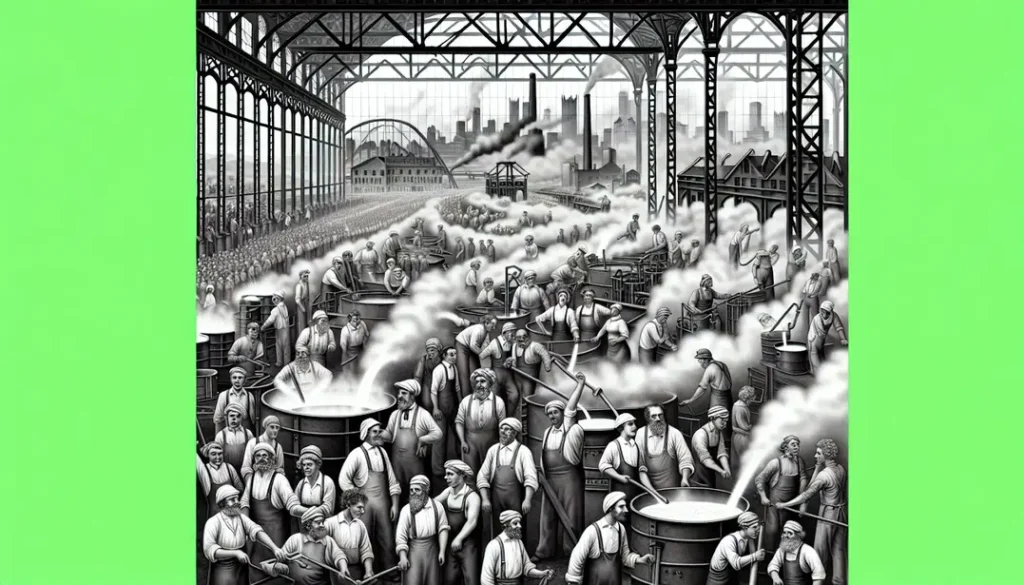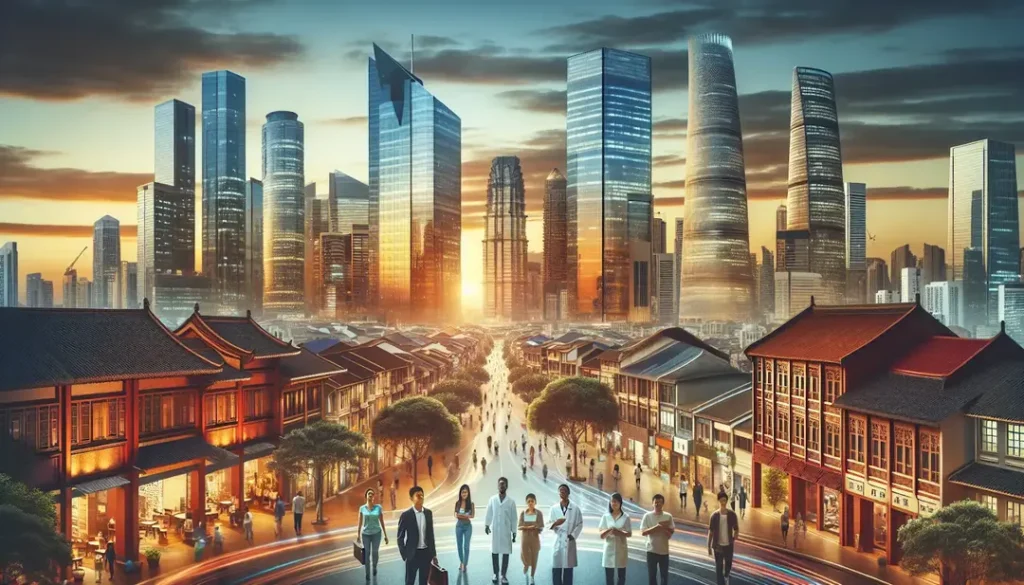Why did Pittsburgh, once a frontier outpost, become an industrial giant, and how has it reinvented itself in the modern era?
This article charts the course of history in Pittsburgh, PA, shedding light on the events and epochs that forged its identity, from colonial struggles to steel domination and beyond to its current tech-driven renaissance.
Key Takeaways
- Pittsburgh has evolved from a strategic military post into a global industrial leader in steel production, with innovators like Andrew Carnegie pioneering the city’s economic transformation.
- The city has been shaped by waves of immigration throughout its history, with diverse communities leaving lasting cultural impacts and playing critical roles in both the workforce and urban expansion.
- Pittsburgh has undergone a renaissance by transitioning from a heavily polluted industrial city to a hub of technology, healthcare, and education while preserving its historical legacy and landmarks.
Birth of “The Point”: From Native Ground to European Foothold
Pittsburgh’s strategic location in Allegheny County, at the confluence of the Allegheny, Monongahela, and Ohio Rivers, played a significant role in its early history within the Ohio Valley. Long before the arrival of European settlers, the area known as ‘The Point’ was home to Paleo-Indians and later tribes such as those of the Adena culture, their existence marked by archaeological finds at sites like the Meadowcroft Rockshelter.
As the 18th century dawned, ‘The Point’ had grown into a vibrant Native American trading ground. It was home to villages like Shannopin’s Town (Seneca), Sawchuk (Lenape), and Chartier’s Town (Shawnee) and was frequented by tribes of the Iroquois Confederacy. However, the peaceful trading ground was soon to become a battleground as European powers sought control over this strategically crucial point.
Understanding the strategic significance of this spot, the French constructed Fort Duquesne in 1754. This fortification soon became a focal point in the French and Indian War, culminating in the British completing the construction of Fort Pitt after the capture of Fort Duquesne. In a similar vein, Fort Prince George played a role in the conflict. This marked the transition of ‘The Point’ from native land to a European foothold, a change that would significantly alter the course of Pittsburgh’s history.
Fort Pitt, established by General John Forbes, marked the British military presence and played a crucial role during conflicts like Pontiac’s Rebellion. This transition from a Native American trading ground to a European military foothold set the stage for Pittsburgh’s future development into a city and an industrial center.
In the centuries that followed, ‘The Point’ would witness remarkable transformations as Pittsburgh grew from a strategic military post into a city of global industrial significance, including the development of the East Liberty neighborhood.
The Forging of an Industrial Giant: Pittsburgh’s Steel Soul

Emerging from its military phase, Pittsburgh morphed into an industrial hub, laying the foundation for its renown as a titan in the steel industry. By 1910, Pittsburgh produced more than 60 percent of the nation’s steel, driven by the entrepreneurial talent of figures like Andrew Carnegie and the adoption of innovative processes like Bessemer’s method of steel production.
At its zenith as a steel juggernaut, Pittsburgh was responsible for nearly half of America’s steel output during the 1910s and 1920s. Andrew Carnegie founded what became the world’s largest and most profitable industrial enterprise. Simultaneously, A.W. Mellon and Henry Clay Frick played pivotal roles in financing and expanding the city’s industrial sector.
Pittsburgh’s steel production was propelled by innovations like the Siemens-Martin open-hearth process, introduced by industry pioneers, reinforcing its economic supremacy in the steel industry. Pittsburgh’s unique geographic position at the confluence of three rivers significantly aided its early industrial activities, including boat building and steel mills, setting a foundation for later industrial expansion.
After the U.S. Constitution’s ratification, Pittsburgh leveraged its abundant natural resources to transition from a political entity to a self-sufficient industrial city. The city’s growth, however, was not just an economic phenomenon. It also attracted a diverse population that would shape Pittsburgh’s cultural landscape.
The Melting Pot Era: Immigration and Urban Expansion
The latter half of the 19th century marked a substantial wave of European immigrants arriving in Pittsburgh. Drawn by job opportunities in the city’s growing industries, these immigrant groups played a pivotal role in Pittsburgh’s expansion. The Pittsburgh area became a significant settlement for Polish immigrants who worked in the coal and steel industries, and their presence is still evidenced in neighborhoods like Lawrenceville and Polish Hill.
These immigrant communities maintained strong nationalistic ties to their European homelands, actively participating in movements such as the formation of Czechoslovakia, as recognized in the Pittsburgh Agreement. Celebrated personalities like Polish nationalist Ignacy Jan Paderewski visited Pittsburgh, reinforcing the city’s role in supporting Eastern European independence during World War I.
Efforts to document Pittsburgh’s ethnic communities, such as The Western Pennsylvania Historical Survey and the collections at the History Center, began in the 20th century and continue to preserve the immigrants’ legacy. Though the rate of immigration has slowed, Pittsburgh remains a destination for immigrants from diverse regions like Asia, Latin America, and South America.
This cultural melting pot would face its sternest test during the tumultuous times of the World Wars.
Two World Wars and the Smoky City
Pittsburgh was instrumental in providing requisite steel during both World War I and World War II, serving as a crucial participant in the industrial war effort. However, this massive industrial activity had a downside. The intensity of steel production caused severe air pollution, earning the city the moniker ‘The Smoky City’ in the early 20th century.
Despite these challenges, Pittsburgh displayed social cohesion and economic resilience during this period. Movements like the union movement in the Mon Valley played a crucial role in helping the city withstand the Great Depression.
Immigrants, who made up a substantial portion of the workforce in companies such as Pittsburgh’s A.M. Byers Company, not only helped in the production of steel during wartime but also served in military forces, further contributing to the war efforts.
However, like a phoenix rising from the ashes, Pittsburgh would undergo a dramatic transformation in the subsequent years, shrugging off its ‘Smoky City’ tag and redefining its identity.
The Renaissance and Rebirth: Pittsburgh’s Modern Metamorphosis

Following the industrial era, Pittsburgh embarked on a path of transformation. The city moved away from its former reliance on steel and heavy industry, with education and healthcare sectors becoming increasingly central to its economy, spurred on by institutions like Carnegie Mellon University and the University of Pittsburgh.
This resurgence was characterized by:
- A unified urban redevelopment initiative known as the Pittsburgh Renaissance
- Bipartisan leadership and corporate investment
- A neater cityscape
- Public spaces such as Mellon Square
- Distinctive architecture, including the Alcoa and U.S. Steel buildings
Innovation in Pittsburgh’s new economy is evidenced by the presence of tech giants like Google and the development of promising startups such as NoWait, representing a significant shift towards a technologically driven business environment. The repurposing of the former LTV Steel plant into the SouthSide Works complex exemplifies Pittsburgh’s commitment to transforming industrial sites into vibrant mixed-use developments, while similar initiatives are taking place on the north side as well.
This modern metamorphosis did not mean forgetting the past. Instead, Pittsburgh found ways to preserve and celebrate its rich historical legacy.
Preserving the Past: Landmarks and Legacy
The preservation and restoration of historical landmarks have played a central role in Pittsburgh’s evolution. Take, for instance, the Fort Pitt Blockhouse, which underwent a rigorous preservation project starting in 2013 due to concerns about its structural integrity. Noninvasive techniques were utilized to evaluate the Blockhouse’s timbers, with subsequent repairs employing structural epoxy and Dutchman repairs to fortify the structure and protect against deterioration.
Furthermore, restoration efforts included masonry work, the installation of steel braces to support original beams, and the application of preservative treatments to exterior elements. Today, the Fort Pitt Blockhouse stands as a testament to the city’s commitment to preserving its historical legacy.
The Steel City’s rich industrial past is celebrated and preserved at sites like the Rivers of Steel National Heritage Area. Efforts by the Pittsburgh History & Landmarks Foundation (PHLF) ensure the renovation and protection of historic structures like the building at 235 Fort Pitt Boulevard. As Pittsburgh’s oldest continuously operating historical site, the Fort Pitt Blockhouse has been a cornerstone of the region’s historical narrative since it opened to the public in July 1895.
Today, modern Pittsburgh is a testament to its rich history, a city that has managed to weave its past into the fabric of its present.
Pittsburgh Today: A History Alive
Presently, Pittsburgh shines as a symbol of change, having seamlessly shifted from an industrial base to a diverse economy with a focus on services, healthcare, academia, and cutting-edge technology. Major tech companies like Google, Apple, and Uber have established campuses in the city, signaling a new era of economic prosperity.
However, it’s worth noting that, despite economic diversification and resilience in the face of the 2008 recession, not all areas of Pittsburgh have fully benefited, with specific neighborhoods still grappling with issues of poverty and racial divisions.
Culturally, the city has seen tremendous growth, especially in the hill district. The successful transformation of 14 blocks into the thriving Cultural District hosts over 1,500 events a year, generating an impressive economic impact and educating future generations of artists.
Pittsburgh is recognized as one of the most livable cities and excels in offering intergenerational economic mobility, making it a conducive place for achieving the American Dream. Major private employers such as the University of Pittsburgh Medical Center and Carnegie Mellon University support stable jobs and economic growth, with significant contributions also from national and global non-profits.
Education in Pittsburgh, PA
As Pittsburgh transitioned from its steel roots to a tech-driven renaissance, education played a pivotal role in shaping its new identity. The city’s transformation is deeply intertwined with the growth of its educational institutions, which have become cornerstones of the community and catalysts for economic and cultural development.
Carnegie Mellon University and the University of Pittsburgh: Catalysts for Change
Central to Pittsburgh’s educational landscape are Carnegie Mellon University (CMU) and the University of Pittsburgh. CMU, renowned for its research in computer science and robotics, has been a driving force in attracting tech companies to the city. Similarly, the University of Pittsburgh, with its strong emphasis on healthcare and medical research, has not only advanced the medical field but also contributed significantly to the local economy. These institutions have been instrumental in transitioning Pittsburgh from an industrial giant to a leader in technology and healthcare.
A Tradition of Educational Excellence
Pittsburgh’s commitment to education is not new; it has a long-standing tradition of valuing academic excellence. Historic schools like Pittsburgh Central Catholic High School, founded in 1927, and Pittsburgh Creative and Performing Arts School, established in 1979, reflect the city’s dedication to providing diverse Pittsburgh educational pathways. These institutions have nurtured generations of Pittsburghers, laying a foundation for a well-educated and versatile workforce.
Community Colleges and Technical Schools: Bridging the Gap
Alongside its universities, Pittsburgh’s community colleges and technical schools play a crucial role in the city’s educational ecosystem. Schools like the Community College of Allegheny County and Pittsburgh Technical College offer accessible education and vocational training, essential for supporting the city’s evolving economic needs. They bridge the gap between traditional education and the practical skills required in the modern workforce.
Impact on Local Economy and Culture
The influence of Pittsburgh’s educational institutions extends beyond academia. They are significant employers and contribute to the city’s cultural richness. University-led community programs, cultural events, and collaborations with local businesses reinforce the symbiotic relationship between Pittsburgh’s academic and urban environments.
Preparing for the Future
As Pittsburgh continues to evolve, its educational institutions are at the forefront, preparing students for the challenges of the 21st century. By fostering innovation, creativity, and critical thinking, these schools ensure that Pittsburgh remains adaptable and forward-thinking, ready to embrace the opportunities of a rapidly changing world.
Summary
From its beginnings as a strategic trading ground to its rise as a steel powerhouse and its modern reincarnation as a diversified, thriving city, Pittsburgh’s journey is a testament to resilience, innovation, and the triumph of community spirit. The city’s rich tapestry of history is a story of transformation, a narrative that continues to be written with every passing day.
Frequently Asked Questions
What is Pittsburgh known for in history?
Pittsburgh is known for being an industrial center for coal mining and steel production due to its navigable waterways and natural resources, such as coal, timber, natural gas, iron, and limestone. This history has left a lasting impact on the city’s identity and development.
What is the most historical site in Pittsburgh?
The most historical site in Pittsburgh is Fort Duquesne. In this significant location, the French and Indian War took place from 1754 to 1758 before being taken over by the British and then the Americans.
What happened 100 years ago in Pittsburgh, PA?
Pittsburgh, PA, was the birthplace of the world’s film industry 100 years ago, with the opening of the Nickelodeon Theater on Smithfield Street in 1905.
What are three interesting facts about Pittsburgh?
Pittsburgh has more bridges than any other city in the world, is home to the world’s first T-rex fossil, and U.S. Steel initially used the Steelers logo.
What was ‘The Point’ in Pittsburgh’s early history?
‘The Point’ in Pittsburgh’s early history refers to its strategic location at the confluence of the Allegheny, Monongahela, and Ohio Rivers, serving as a critical Native American trading ground before becoming a European military foothold. This made it a crucial location for early settlement and trade.
